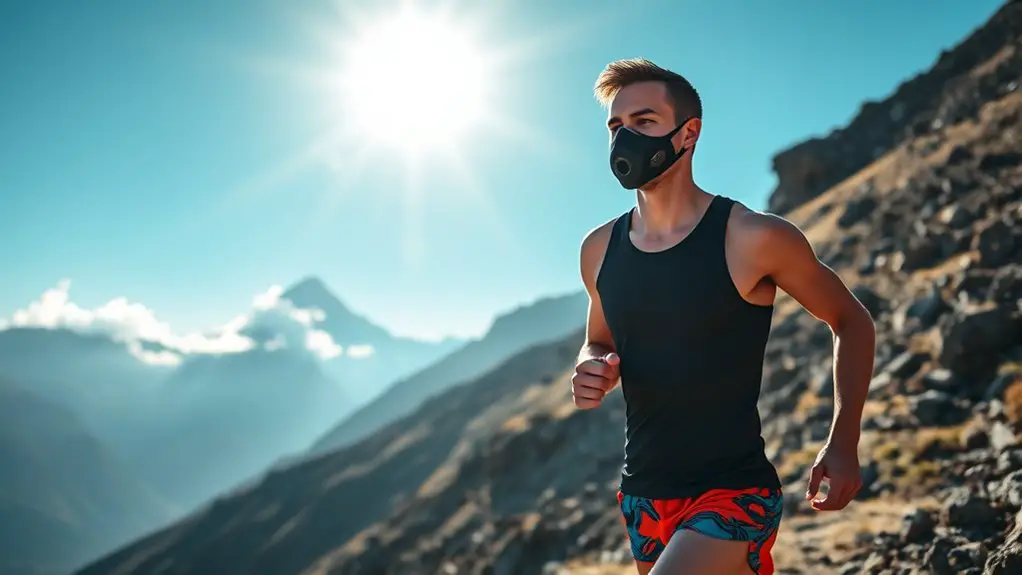Altitude masks can greatly enhance your endurance training by mimicking high-altitude conditions. They restrict airflow, improving your oxygen efficiency and promoting adaptations that boost your respiratory performance. As you train, you'll notice increased red blood cell production and greater muscle efficiency. However, using these masks requires caution to avoid risks like dizziness or fatigue. Want to know more about how to effectively incorporate altitude masks into your regimen? There's more to explore about optimizing your training!
The Science Behind Altitude Masks
While you might think altitude masks are just another fitness trend, there's actual science behind their use. These masks simulate high-altitude conditions, restricting airflow to mimic reduced oxygen levels. By wearing one, you're forcing your body to adapt, which can lead to various physiological benefits. Your lungs work harder to get the oxygen you need, leading to improved respiratory efficiency.
Moreover, as your body adjusts, it stimulates the production of red blood cells, enhancing your oxygen-carrying capacity. This adaptation can help you perform better during endurance activities, making you feel more liberated in your pursuits. Incorporating altitude masks into your training regimen can complement high-intensity interval training and maximize your overall performance.
However, it's crucial to use altitude masks wisely; overdoing it can lead to fatigue or dizziness. Incorporating them into your training could provide an edge, but balance is key. So, if you're ready to elevate your game, consider the science behind altitude masks as a tool for your journey towards greater freedom in fitness.
How Oxygen Availability Affects Performance
When you're exercising, your body demands more oxygen to fuel performance. As you adapt to reduced oxygen levels, it can lead to improved endurance and efficiency. Plus, understanding how oxygen availability impacts recovery times is vital for maximizing your training results.
Oxygen Demand During Exercise
Oxygen availability plays an essential role in your performance during exercise, as it directly impacts your body's ability to produce energy. When you're pushing your limits, the demand for oxygen increases, and if there's not enough to meet that demand, your performance can suffer. Understanding how oxygen affects your workout can help you optimize your training.
- Increased oxygen supply enhances endurance
- Insufficient oxygen leads to fatigue
- Oxygen-rich environments boost performance
- Training adaptations improve oxygen utilization
Adaptation to Reduced Oxygen
As you train in environments with reduced oxygen, your body begins to adapt in remarkable ways. You'll notice your muscles becoming more efficient at utilizing oxygen, enhancing your endurance. Your red blood cell count increases, allowing more oxygen to be transported to your tissues. This means your body learns to perform better under stress, pushing through fatigue with newfound strength. Your breathing patterns may also change, allowing you to take in more oxygen during exertion. These adaptations not only help you during high-altitude training but also translate to improved performance at lower altitudes. Embracing this challenge can lead to a sense of freedom, revealing your potential and allowing you to experience the true limits of your endurance.
Impact on Recovery Times
Training in reduced oxygen environments not only boosts endurance but also greatly impacts your recovery times. When you're pushing your limits in lower oxygen settings, your body adapts in ways that can make recovery faster and more effective. Here's how oxygen availability influences your recovery:
- Increased blood flow: Enhanced circulation helps clear out metabolic waste.
- Improved muscle repair: Adaptations in protein synthesis speed up recovery.
- Enhanced hormonal response: Your body releases growth hormones that aid tissue recovery.
- Reduced fatigue: Training in these conditions can lower overall fatigue levels post-exercise.
Physiological Adaptations to Reduced Airflow
When you train with altitude masks, your body adapts to the reduced airflow, leading to improved oxygen utilization efficiency. This means that you'll become better at making the most of the oxygen available during your workouts. Additionally, your respiratory muscles may strengthen, helping you breathe more effectively over time.
Oxygen Utilization Efficiency
While altitude masks aim to simulate high-altitude conditions by reducing airflow, they also foster significant physiological adaptations that enhance oxygen utilization efficiency. When you train with these masks, your body learns to optimize how it uses oxygen, allowing you to perform better even at sea level. Here's how this improvement manifests:
- Increased capillary density in muscles
- Enhanced mitochondrial function for energy production
- Improved oxygen transport and delivery to tissues
- Greater reliance on fat as a fuel source
These adaptations lead to better endurance, so you can push your limits and achieve your fitness goals. Embracing this challenge brings a sense of freedom, empowering you to explore and redefine your capabilities.
Increased Respiratory Muscle Strength
As your body adapts to the challenges posed by altitude masks, another significant benefit emerges: increased respiratory muscle strength. When you train with these masks, you're forcing your respiratory muscles to work harder against restricted airflow. This resistance helps build endurance in your diaphragm and intercostal muscles, enhancing your lung capacity and efficiency. You'll notice that as your respiratory muscles strengthen, your overall stamina improves during workouts. This newfound strength can translate into better performance, allowing you to push your limits and explore your potential. With stronger respiratory muscles, you'll find it easier to sustain intense efforts, giving you the freedom to tackle longer runs, climbs, or any endurance challenge that comes your way. Embrace the journey and breathe deep!
The Role of Breathing Techniques in Endurance
Breathing techniques play an essential role in enhancing endurance, especially for athletes pushing their limits. Mastering how you breathe can lead to improved performance and greater freedom during your workouts. Here are some key techniques to take into account:
- Diaphragmatic Breathing: Engage your diaphragm for deeper, more efficient breaths.
- Rhythmic Breathing: Sync your breath with your movements to maintain a steady pace.
- Nasal Breathing: Breathe through your nose to filter air and increase oxygen absorption.
- Pursed-Lip Breathing: Exhale slowly through pursed lips to control your breath and reduce fatigue.
Incorporating these techniques into your training can help you maximize oxygen intake, reduce anxiety, and improve stamina. Each breath taken with intention empowers you, allowing you to break barriers and reach new heights in your endurance journey. Embrace the freedom that comes with mastering your breath, and watch your performance soar.
Comparing Altitude Masks to Natural High-Altitude Training
When you're considering altitude masks versus natural high-altitude training, it's essential to look at the physiological adaptations each method offers. You might wonder how they impact your performance and which is more accessible for your training routine. Let's break down these factors to see what works best for you.
Physiological Adaptations Explained
Altitude training, a method used by athletes to enhance performance, can be replicated to some extent with altitude masks. While these masks simulate reduced oxygen levels, they don't fully mimic the physiological adaptations gained through natural high-altitude training. Here's what you can expect with both methods:
- Increased red blood cell production: Your body boosts RBCs to transport oxygen more efficiently.
- Improved VO2 max: Both methods enhance your aerobic capacity, but natural training often yields greater results.
- Enhanced capillary density: Training at altitude promotes more capillaries, improving oxygen delivery to muscles.
- Altitude acclimatization: Natural exposure fosters long-term adaptations that masks can't fully replicate.
Embrace the journey, and find what works best for your endurance training!
Performance Impact Analysis
While both altitude masks and natural high-altitude training aim to enhance athletic performance, their impacts can differ considerably. Altitude masks simulate reduced oxygen levels, promoting adaptations like increased red blood cell production. However, they often fall short of replicating the full physiological benefits you get from training at high altitudes, where the body undergoes a natural acclimatization process. Natural training exposes you to lower oxygen for extended periods, allowing your body to adapt more effectively. You'll likely notice this when it comes to endurance and stamina. Basically, while masks offer a convenient alternative, they can't entirely replace the profound benefits of genuine high-altitude training. It's all about how you want to optimize your performance and embrace your training journey.
Accessibility and Practicality Considerations
Natural high-altitude training can be challenging to access for many athletes due to geographical limitations and the costs associated with travel and accommodation. Altitude masks offer a more practical solution, allowing you to simulate high-altitude conditions right where you are. This convenience can help you maintain your training routine without the hassle and expense of traveling. Consider these points when weighing your options:
- Cost-effective: No travel expenses or hotel stays needed.
- Flexibility: Train anywhere—home, gym, or outdoors.
- Consistent training: Avoid disruptions in your schedule.
- Accessibility: Available to everyone, regardless of location.
Ultimately, altitude masks provide a liberating alternative, enabling you to train effectively without the constraints of natural high-altitude environments.
Potential Benefits for Athletes
When athletes incorporate altitude masks into their training, they may experience several potential benefits that can enhance performance. First, these masks simulate high-altitude conditions, which can improve your body's oxygen efficiency. As you adapt to lower oxygen levels, your endurance capacity can increase, helping you push through tough workouts.
You might also notice enhanced lung capacity and respiratory strength, allowing for better oxygen intake during intense activities. This can lead to quicker recovery times, meaning you can train harder and more frequently.
Additionally, using an altitude mask can boost mental toughness. As you face the challenge of restricted breathing, you'll build resilience, which can be invaluable during races or competitions. Furthermore, this training method aligns with the concept of enhancing fat utilization, as it encourages your body to become more efficient at using different fuel sources during prolonged exercise.
Risks and Considerations When Using Altitude Masks
Although altitude masks can offer various benefits, there are important risks and factors to keep in mind. While you might feel excited about enhancing your training, it's essential to approach altitude training thoughtfully. Here are some key points to take into account:
- Breathing Difficulties: You may experience shortness of breath or dizziness, especially if you're not accustomed to lower oxygen levels.
- Overexertion: It's easy to push yourself too hard, thinking you're training at a higher level than you actually are.
- Inaccurate Measurements: Masks can sometimes provide misleading data about your performance, leading to false confidence.
- Adaptation Period: Your body needs time to adjust; jumping in too quickly can lead to injuries or burnout.
Additionally, remember that staying hydrated is crucial, as dehydration can impair energy and focus, making it even more important to monitor your fluid intake while training at high altitudes. Being mindful of these factors can help you make the most of your altitude training while minimizing risks. Stay informed, and prioritize your well-being on your journey to peak performance.
User Experiences and Testimonials
Have you ever wondered how altitude masks actually impact training from the perspective of users? Many athletes swear by them, claiming they've transformed their endurance. You might find it inspiring to hear how real users feel about their experiences.
Here's a quick overview of some testimonials:
| User | Experience |
|---|---|
| Sarah, Runner | "I felt my lung capacity improve!" |
| Mike, Cyclist | "It pushed my limits like never before." |
| Jenna, Triathlete | "Training with it made races easier." |
These insights show how altitude masks can lead to noticeable gains in performance. Users appreciate the challenge they provide, claiming it's like training at high altitudes without leaving home. You might just find that this tool fuels your desire for freedom in your training journey!
Best Practices for Incorporating Altitude Masks Into Training
To get the most out of altitude masks in your training, it's essential to incorporate them strategically rather than diving in headfirst. Start slow and listen to your body, as this will help you adjust to the changes without overwhelming yourself. Here are some best practices to keep in mind:
Incorporate altitude masks gradually in your training to optimize benefits and prevent overwhelm. Listen to your body.
- Gradual Introduction: Begin with shorter sessions and gradually increase duration as you adapt.
- Mix It Up: Combine altitude mask training with regular workouts to maintain balance and overall performance.
- Monitor Your Efforts: Keep track of your heart rate and perceived exertion to guarantee you're not overdoing it.
- Stay Hydrated: Proper hydration is critical, as altitude training can increase your fluid needs. Additionally, incorporating easy runs into your routine can enhance recovery and support your adaptation to altitude training.
Future Research Directions on Altitude Training Methods
As athletes continue to explore the benefits of altitude masks in their training, it's clear that research on altitude training methods is evolving. Future studies should focus on how different mask designs influence performance, recovery, and overall endurance. By comparing varying levels of oxygen restriction, researchers can better understand which configurations optimize training benefits while minimizing risks.
Additionally, examining the psychological effects of altitude training could open new mental strategies for athletes. Understanding how the perceived effort changes with altitude exposure may lead to tailored motivational techniques.
Finally, longitudinal studies on the long-term effects of altitude training could provide insights into its sustainability and impact on different sports. There's a need for diverse athlete populations in these studies to guarantee findings are applicable across various disciplines. By pursuing these avenues, we can truly harness the potential of altitude training methods for maximizing athletic performance.
Frequently Asked Questions
Can Altitude Masks Simulate High-Altitude Conditions Effectively?
Altitude masks can't truly replicate high-altitude conditions. While they restrict airflow, limiting oxygen intake, they don't match the physiological changes your body experiences at real altitude. You're better off training in genuine high-altitude environments for ideal results.
Do Altitude Masks Improve Performance in Sea-Level Training?
You might think altitude masks turn you into a superhuman, but they don't guarantee performance boosts at sea level. They can help with breathing efficiency, but it's not a magic solution for everyone.
How Long Should I Train With an Altitude Mask?
You should train with an altitude mask gradually, starting with short sessions, about 20-30 minutes, and increase as you adapt. Consistency's key, so aim for a few times a week to see benefits.
Are There Specific Exercises Best Suited for Altitude Mask Training?
For focused fitness, try fundamental exercises like fast-paced running, cycling sprints, or functional strength training. These activities amplify your altitude mask experience, enhancing endurance while granting you the freedom to explore your physical limits.
Can Altitude Masks Help With Weight Loss During Workouts?
Altitude masks might not directly lead to weight loss, but they can increase workout intensity. If you push yourself harder, you're likely to burn more calories, so it could help you reach your fitness goals.


